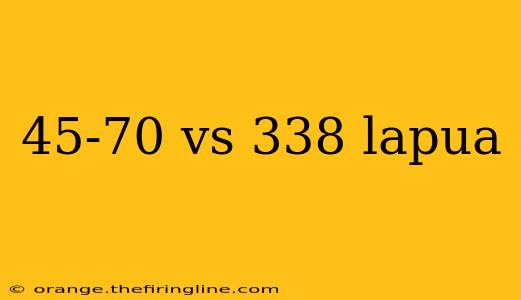Choosing the right cartridge for long-range shooting is a crucial decision, heavily influenced by the intended application and personal preferences. This detailed comparison explores the strengths and weaknesses of two popular, yet vastly different, calibers: the venerable .45-70 Government and the modern powerhouse, the .338 Lapua Magnum. We'll delve into their ballistics, applications, and overall suitability for different shooting scenarios.
Ballistics: A Tale of Two Calibers
The .45-70 Government and the .338 Lapua Magnum occupy distinct niches in the long-range shooting world. Their ballistic profiles highlight these differences:
.45-70 Government:
- Caliber: .458 inch (11.6 mm)
- Weight: Heavy, typically ranging from 300 to 500 grains.
- Velocity: Relatively low compared to the .338 Lapua Magnum, typically around 2000-2200 fps (feet per second) depending on the load and barrel length.
- Energy: High retained energy at close to medium ranges due to its substantial bullet weight.
- Trajectory: Steep trajectory, requiring significant compensation at longer distances.
- Recoil: Significant recoil, requiring a robust rifle and shooter experience.
.338 Lapua Magnum:
- Caliber: .338 inch (8.6 mm)
- Weight: Generally lighter than .45-70 bullets, typically ranging from 200 to 300 grains.
- Velocity: Substantially higher than .45-70, reaching velocities of 2800 fps and above depending on load and barrel length.
- Energy: High retained energy at long ranges due to its higher velocity and aerodynamic bullet design.
- Trajectory: Relatively flatter trajectory compared to .45-70, making long-range shots more predictable.
- Recoil: High recoil, although often perceived as more manageable than the .45-70's heavier, slower recoil impulse.
Applications: Where Each Cartridge Shines
The optimal choice depends heavily on the intended application.
.45-70 Government:
- Hunting: Exceptional for large, dangerous game at closer ranges. Its substantial bullet weight delivers devastating energy, making it effective on bears, elk, and other heavy animals. It's less suitable for long-range hunting due to its trajectory.
- Competition: While less common in long-range shooting competitions, it finds a niche in certain traditional shooting disciplines.
- Self-Defense: (Specific situations only) – Its stopping power is considerable, making it suitable for certain self-defense scenarios, though its portability needs to be considered.
.338 Lapua Magnum:
- Long-Range Shooting: This cartridge excels in long-range target shooting and hunting. Its flat trajectory and high velocity allow for accurate shots at extreme distances (1000+ yards).
- Hunting: Extremely effective for large game at long ranges, offering precision shots on animals like elk and moose beyond the capabilities of the .45-70.
- Military/Law Enforcement: Often employed by snipers and military personnel for its accuracy and long-range capabilities.
Rifle Considerations
The rifle platform is crucial. A .45-70 rifle will be substantially different from a .338 Lapua Magnum rifle, reflecting the cartridges' contrasting requirements:
- .45-70 Rifles: Typically heavier, more robust actions built to handle the high recoil.
- .338 Lapua Magnum Rifles: Often feature heavier barrels for improved accuracy and heat dissipation, designed for long-range precision and recoil management.
Conclusion: Choosing the Right Tool for the Job
The .45-70 Government and the .338 Lapua Magnum are both powerful cartridges, but they serve vastly different purposes. The .45-70 is a potent close-to-medium-range round ideal for large game hunting, while the .338 Lapua Magnum is a long-range precision cartridge suitable for extreme-distance shooting and hunting. Careful consideration of the intended application is paramount when choosing between these two distinct calibers.

